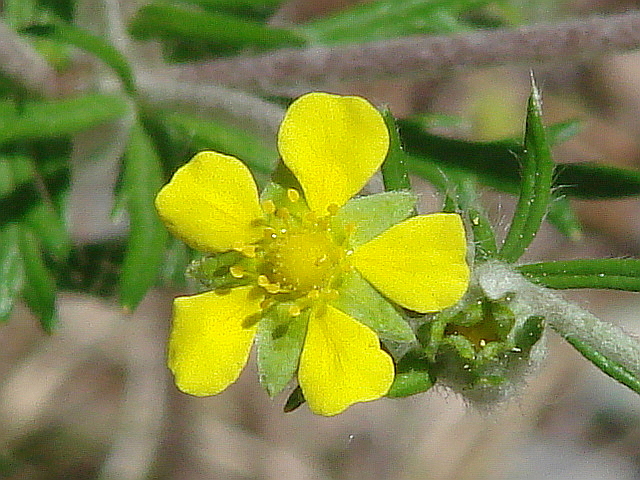Potentilla argentea
Potentilla supina
hoary cinquefoil, silver cinquefoil
bushy cinquefoil
Leaves mainly cauline, 5-10 per stem, palmately divided, the leaflets 5, 1-2 cm. long, oblanceolate, with coarse serrate teeth over half way to the mid-vein;
stipules lanceolate, entire, 4-8 mm. long.
Leaves pinnate, the lower ones with 2-4 pairs of elliptic to oblong leaflets with rounded serrations, 1-3 cm. long, the upper sometimes ternate;
stipules well-developed.
Inflorescence open, branched, many-flowered, leafy-bracteate;
calyx 4-6 mm. broad, silky, the 5 lobes ovate-lanceolate, 2-3 mm. long, alternating with linear, shorter bracteoles;
petals 5, yellow, obovate with a wedge-shaped base, equaling the sepals;
stamens 20;
pistils numerous, the styles thickened and glandular at the base, tapered upward, attached to the end of the achene.
Flowers solitary on long peduncles from the leaf axils throughout the upper half of the plant;
calyx stiff-hairy, 5-9 mm. broad, the 5 lobes ovate-triangular, 3-4 mm. long, erect;
petals 5, yellow, obovate, about equal to the sepals;
stamens usually 20, sometimes less;
pistils numerous;
style terminal, equaling the ovary.
Achene 0.6-0.8 mm. long, the same length as the style.
Achenes 1.2 mm. long with a wedge-shaped thickening on one edge about the size of the rest of the fruit.
Potentilla argentea
Potentilla supina
- Local floras:
BC,
OR,
WA
- Local Web sites:
Flora NW,
PNW Herbaria
WildflowerSearch
iNaturalist (observations)
USDA Plants Database
- LBJ Wildflower Center
- SEINet
- Plants of the World Online
- Encyclopedia of Life
- Wikipedia
- Google Image Search



